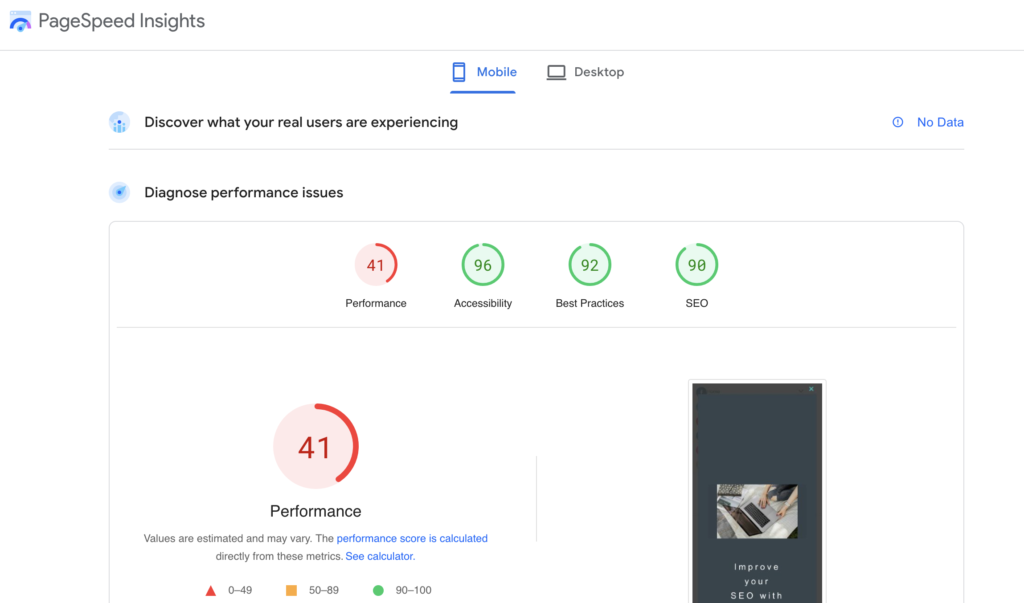Website speed is one of the key factors in improving your SEO and creating an effortless user experience. ‘In a 2019 survey by Unbounce, nearly 70% of consumers admitted that page speed impacts their willingness to buy from an online retailer.’
‘The first five seconds of page-load time have the highest impact on conversion rates. (Portent, 2019)’ and ‘website conversion rates drop by an average of 4.42% with each additional second of load time (between seconds 0-5).’
SEMrush declares that page load time is a primary ranking factor. It also effects conversion rate too. ‘A 1-second delay in your site speed can result in a 7% reduction in conversions.’
Why do you need to improve your site speed?
There are several reasons why it’s important to improve the speed of a website:
- User experience: A slow website can be frustrating for users and may lead them to leave the site and go to a competitor’s site. Improving the speed of your website can improve the user experience and keep visitors on your site longer.
- Search engine rankings: Google and other search engines use page speed as a ranking factor in their search results. A faster website is more likely to rank higher in the search results, which can lead to more traffic and potential customers for your business.
- Conversion rates: A faster website can lead to higher conversion rates, as users are more likely to complete a purchase or take the desired action on a site that loads quickly, as we’ve seen from the stat above.
- Reduced bounce rates: A slow website can lead to high bounce rates, as users may leave the site before it has finished loading. Improving the speed of your website can reduce bounce rates and improve your site’s overall performance.
How to improve site speed
There are many ways to improve the speed of a website. Here are a few general tips:
- Optimise images: Large images can slow down a website, so it’s important to optimise them by compressing them or resizing them to a more appropriate size.
- Enable compression: Compressing resources such as HTML, CSS, and JavaScript files can reduce the size of these files and speed up your website’s loading.
- Minimise the use of plugins: Too many plugins can slow down a website, so it’s important to only use the ones that are absolutely necessary.
- Use a content delivery network (CDN): A CDN is a network of servers that delivers web pages and other web content to a user based on the geographic location of the user, the origin of the webpage and the content delivery server.
- Optimise your website’s code: Optimising your website’s code can help reduce the amount of time it takes for a page to load. This can involve reducing the number of lines of code, minimising the use of unnecessary code, and optimising the order in which code is loaded.
- Use caching: Caching allows a website to store commonly used resources on the user’s computer, so they don’t have to be downloaded each time the user visits the website. This can significantly improve the speed of the website.
- Optimise the website’s server: If the website’s server is not optimised, it can slow down the website. You can improve the server’s performance by optimising the database, using a faster web server, and optimising the server’s configuration.
These are just a few general tips to improve the speed of a website. It’s also important to regularly monitor the performance of your website and make adjustments as needed to ensure it remains fast and efficient. See below for tools that can help with this.
How do you optimise images for site speed?
There are several ways to optimise images for site speed:
- Compress images: Using image compression tools, you can reduce the file size of images without significantly affecting their quality. This can help reduce the amount of time it takes for the images to load on your website.
- Resize images: If an image is larger than it needs to be for the space it’s being used in, it can slow down the loading time of your website. Resizing images to the appropriate size can improve the speed of your website.
- Use appropriate image file types: Different image file types are better suited for different types of images. For example, JPEG is a good choice for photographs, while PNG is better for graphics with transparent backgrounds. Choosing the appropriate file type can help reduce the file size of images and improve the speed of your website.
- Use lazy loading: Lazy loading is a technique that delays the loading of images until they are needed. This can help improve the speed of your website by reducing the amount of data that needs to be loaded at once.
- Use a CDN: A content delivery network (CDN) is a network of servers that delivers web pages and other web content to a user based on the geographic location of the user, the origin of the webpage and the content delivery server. Using a CDN can help improve the speed of your website by reducing the distance that data needs to travel.
- Optimise image file names: Using descriptive, keyword-rich file names for your images can help improve the speed of your website by making it easier for search engines to understand what the images are about. Get a 14-day trial of SEO software here.
- By following these tips, you can optimise images for site speed and improve the overall performance of your website.
How many plugins should I use for good site speed?
The number of plugins that you should use on your website depends on the specific needs of your site and how well-optimised the plugins are. In general, it’s best to use as few plugins as possible, as each plugin you add to your website can potentially add more code and resources that need to be loaded, which can slow down your website.
That being said, there are some plugins that are essential for the functionality of your website and can actually improve the speed of your site. For example, a caching plugin can help speed up your website by storing commonly used resources on the user’s computer, so they don’t have to be downloaded each time the user visits the website.
It’s important to carefully evaluate the need for each plugin you are considering using and to only use those that are necessary for the functionality and performance of your website. If you do use multiple plugins, make sure to keep them up to date and optimise them for performance. It’s also a good idea to regularly review the plugins you are using and consider removing any that are no longer necessary or that may be slowing down your website.
How do plugins slow your website down?
Plugins can slow down a website for a few reasons:
- Extra code: Each plugin you add to your website adds more code that needs to be loaded every time a page is requested. This can increase the amount of time it takes for a page to load, especially if the plugin has a lot of code or if you are using multiple plugins.
- Resource-intensive: Some plugins may be resource-intensive, meaning they require a lot of resources (such as CPU, memory, or database queries) to function properly. This can slow down your website, especially if you are using multiple resource-intensive plugins or if your server is not powerful enough to handle the demand.
- Poorly optimised: If a plugin is poorly coded or not optimised for performance, it can slow down your website. It’s important to use well-written, optimised plugins to ensure that they don’t negatively impact the speed of your website.
By using as few plugins as possible and carefully evaluating the need for each plugin you use, you can help ensure that your website performs well and loads quickly. This is something that trips me up all the time. I love a good plugin, but I tend to overload my site with them and forget to disable those that are no longer working for me. And then my site crashes or takes ages to load. Oops!
It’s also important to keep your plugins up to date and to optimise them for performance to ensure that they don’t slow down your website.
How do you enable compression on your website?
There are a few ways to enable compression on your website:
Use a plugin: Many popular content management systems (CMS) have plugins that can enable compression on your website. For example, WordPress has several plugins that can enable Gzip compression, such as W3 Total Cache and Autoptimize.
Use mod_deflate: If you are using an Apache web server, you can enable compression by using the mod_deflate module. To do this, you will need to edit the .htaccess file in the root directory of your website and add the following code:
<IfModule mod_deflate.c>
# Compress HTML, CSS, JavaScript, Text, XML and fonts
AddOutputFilterByType DEFLATE application/javascript
AddOutputFilterByType DEFLATE application/rss+xml
AddOutputFilterByType DEFLATE application/vnd.ms-fontobject
AddOutputFilterByType DEFLATE application/x-font
AddOutputFilterByType DEFLATE application/x-font-OpenType
AddOutputFilterByType DEFLATE application/x-font-otf
AddOutputFilterByType DEFLATE application/x-font-TrueType
AddOutputFilterByType DEFLATE application/x-font-ttf
AddOutputFilterByType DEFLATE application/x-javascript
AddOutputFilterByType DEFLATE application/xhtml+xml
AddOutputFilterByType DEFLATE application/XML
AddOutputFilterByType DEFLATE font/opentype
AddOutputFilterByType DEFLATE font/otf
AddOutputFilterByType DEFLATE font/ttf
AddOutputFilterByType DEFLATE image/svg+xml
AddOutputFilterByType DEFLATE image/x-icon
AddOutputFilterByType DEFLATE text/CSS
AddOutputFilterByType DEFLATE text/HTML
AddOutputFilterByType DEFLATE text/javascript
AddOutputFilterByType DEFLATE text/plain
AddOutputFilterByType DEFLATE text/XML
</IfModule>
Use nginx: If you are using an nginx web server, you can enable compression by adding the following code to your nginx.conf file:
gzip on;
gzip_comp_level 6;
gzip_vary on;
gzip_min_length 1000;
gzip_proxied any;
gzip_types text/plain text/CSS application/JSON application/javascript application/x-javascript text/XML application/XML application/xml+rss text/javascript;
gzip_buffers 16 8k;
These are just a few ways to enable compression on your website. It’s important to note that compression can impact the performance of your server, so it’s essential to carefully consider the trade-offs between increased performance and increased resource usage when enabling compression.
What is a content delivery network?
A content delivery network (CDN) is a distributed network of servers that delivers web pages and other web content to users based on their geographic location, the origin of the webpage, and the content delivery server.
CDNs are used to improve the performance and speed of websites by reducing the distance that data needs to travel between the user and the server and by offloading traffic from the main server. CDNs work by storing copies of a website’s content on servers located in strategic locations around the world. When a user requests content from a website, the CDN will serve the content from the server that is closest to the user, reducing the amount of time it takes for the content to be delivered.
CDNs are commonly used by websites that receive a large amount of traffic or that serve users from around the world, as they can help improve the performance and reliability of the website. CDNs can also enhance the security of a website by providing features such as DDoS protection, SSL/TLS encryption, and rate limiting.
How to use a content delivery network
A content delivery network (CDN) is a network of servers that delivers web pages and other web content to a user based on the geographic location of the user, the origin of the webpage and the content delivery server. Using a CDN can help improve the speed and performance of your website in a few ways:
- Reduce the distance that data needs to travel: By storing copies of your website’s content on servers located around the world, a CDN can reduce the distance that data needs to travel between the user and the server, which can improve the speed at which content is delivered.
- Offload traffic from your main server: A CDN can help reduce the load on your main server by handling some of the traffic that would normally be served by your main server. This can help improve the performance of your website, especially during periods of high traffic.
- Improve security: A CDN can help improve the security of your website by providing features such as DDoS protection, SSL/TLS encryption, and rate limiting.
- To use a CDN, you will need to sign up for a CDN service and configure your website to use the CDN. This typically involves adding a few lines of code to your website’s configuration files and pointing your domain name to the CDN. Some CMS platforms, such as WordPress, have plugins that can help you set up and manage a CDN for your website.
How can you optimise your website’s server?
There are several ways to optimise your website’s server to improve its performance:
- Optimise the database: The database is a critical component of many websites, and optimising it can improve the performance of your website. This can involve optimising the database’s configuration, such as setting the appropriate cache sizes and optimising the indexes, as well as optimising the database’s queries and structure.
- Use a faster web server: Using a faster web server can improve the performance of your website by reducing the time it takes to process requests and serve content.
- Optimise the server’s configuration: There are many configuration options that can impact the performance of your server. Optimising these options can help improve the performance of your website. This can involve setting appropriate resource limits, disabling unnecessary services, and optimising the server’s networking configuration.
- Use a load balancer: If you have a high-traffic website, using a load balancer can help distribute the load across multiple servers, which can improve the performance of your website.
- Use a content delivery network (CDN): A CDN is a network of servers that delivers web pages and other web content to a user based on the geographic location of the user, the origin of the webpage and the content delivery server. Using a CDN can help improve the performance of your website by reducing the distance that data needs to travel between the user and the server and by offloading traffic from your main server.
What tools are available to check your site speed?
There are many tools available to check the speed of a website. Here are a few popular options:
- Google PageSpeed Insights: This tool analyses a webpage and provides recommendations for improving its speed and performance. It also provides a score based on how well the page performs based on this criteria.
- GTmetrix: This tool analyses a webpage and provides recommendations for improving its speed and performance, as well as providing detailed information about the page’s performance and the resources it uses.
- Pingdom: This tool allows you to test the speed of a webpage from various locations around the world and provides a detailed report on the page’s performance, including the time it takes to load and the size of the resources it uses.
- WebPageTest: This tool allows you to test the speed of a webpage from various locations around the world and provides a detailed report on the page’s performance, including the time it takes to load and the size of the resources it uses.
- Lighthouse: This tool is a performance auditing tool that is built into Google Chrome. It can be used to analyse the performance of a webpage and provide recommendations for improving its speed and performance.


What is the right loading speed for your website?
The right loading speed for a website will depend on a variety of factors, including the size and complexity of the site, the type of content it serves, and the target audience. In general, it’s a good goal to aim for a loading speed of under 2 seconds for most websites.
That being said, there is no one-size-fits-all answer to what the “right” loading speed for a website is. It’s important to consider the specific needs of your website and your target audience when determining the right loading speed for your site.
It’s also important to note that the ideal loading speed can vary depending on the type of device and connection that a user is using. For example, users accessing your website on a high-speed broadband connection may be able to tolerate slightly longer loading times than users on a slower mobile network.
It’s a good idea to regularly test the loading speed of your website and make any necessary adjustments to improve its performance with the handy hints above. Because there’s no point having great SEO content and all the SEO factors in place if your site takes an eon to load.
Loving helpful articles like this? Sign up to get them sent directly to your inbox, along with discounts, sales, templates, helpful hints and resources.




